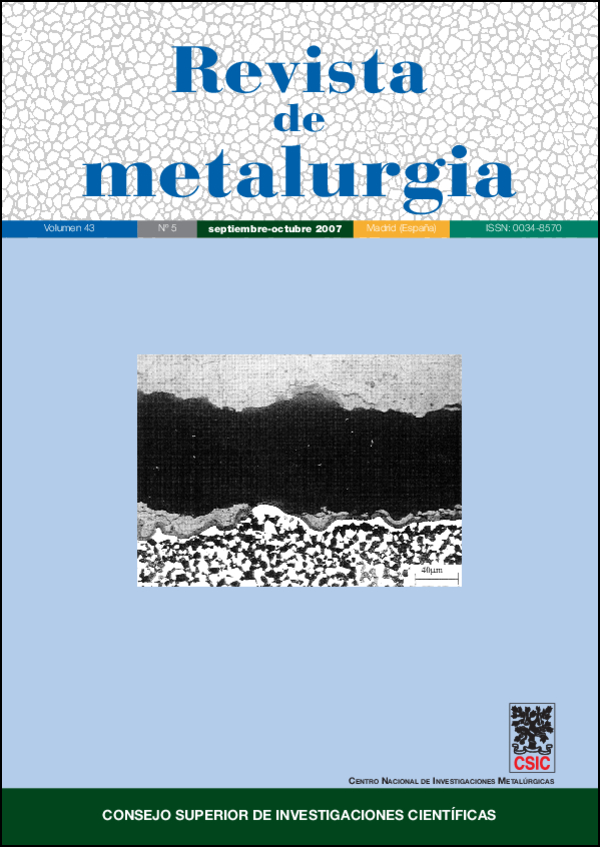Reduce of adherence problems in galvanised processes through data mining techniques
DOI:
https://doi.org/10.3989/revmetalm.2007.v43.i5.77Keywords:
Decision trees, Hot dip galvanizing line, Data mining, Database knowledge discovery, Industrial process improvement, Process parameter analysisAbstract
This paper presents an example of the application of data mining techniques to obtain hidden knowledge from the historical data of a hot dip galvanizing process and to establish rules to improve quality in the final product and to reduce errors in the process. For this purpose, the tuning records of a hot dip galvanizing line where coils with adherence problems in the zinc coating had been identified were used as a starting point. From the database of the process, the classical data mining approach was applied to obtain and analyze a number of decision trees that classified two types of coils, i.e. those with the right adherence and those with irregular adherence. The variables and values that might have influenced the quality of the coating were extracted from these trees. Several rules that may be applied to reduce the number of faulty coils with adherence problems were also established.
Downloads
References
[1] O. Domínguez, J. M. Miranda-Ariz y L. Salvador. Rev. Metal. Madrid 38 (2002) 108-116.
[2] A. Gorni, The modelling of hot rolling processes using neural networks, http://www.gorni.eng.br/e/neural_1998.html, 1998.
[3] F. J. Martínez-De Pisón, Tesis Doctoral, Escuela Técnica Superior de Ingeniería Industrial, Universidad de La Rioja, 2003.
[4] J. A. González-Rodríguez, Tesis Doctoral, Universidad de Oviedo, 1994.
[5] F. J. Martínez-De Pisón, F. Alba-Elías, M. Castejón-Limas y J. A. González Rodríguez, Ironmaking Steelmaking 33 (2006) 1-9.
[6] J. Hernández-Orallo, M. J. Ramírezquintana y C. Ferri-Ramírez, Introducción a la Minería de Datos, Pearson Educación S.A., Prentice Hall, Madrid, España, 2004.
[7] J. R. Quinlan, Machine Learning 1 (1986) 81-106.
[8] J. Zueco y F. Alhama, Rev. Metal. Madrid 41 (2005) 227-232.
[9] J. H. Wei y H. T. Hu, Ironmaking Steelmaking 32 (2005) 427-434. doi:10.1179/174328105X48133
[10] A. Monsalve, A. Artigas, D. Celentano y F. Meléndez, Rev. Metal. Madrid 40 (2004) 247-258.
[11] D. M. Jones, J. Watton y K. J. Brown, Ironmaking Steelmaking 32 (2005) 435-442. doi:10.1179/174328105X48151
[12] C. Camurri. Rev. Metal. Madrid 39 (2003) 132-139.
[13] A. Pernía-Espinoza, M. Castejón-Limas, A. González-Marcos y V. Lobato-Rubio, Ironmaking Steelmaking 32 (2005) 418-426. doi:10.1179/174328105X28829
[14] C. Cantera, J. Jiménez, I. Varela y A. Formoso. Rev. Metal. Madrid 38 (2002) 243-248.
[15] J. Ordieres-Meré, A. González-Marcos, J. A. González, y V. Lobato-Rubio, Ironmaking Steelmaking 31 (2004) 43-50. doi:10.1179/030192304225012060
[16] Z. Sterjovski, D. Nolan, K. R. Carpenter, D. P. Dunne y J. Norrish, J. Mater. Process. Technol. 170 (2005) 536-544. doi:10.1016/j.jmatprotec.2005.05.040
[17] R. Valentini, V. Colla y M. Vannucci, Rev.Metal. Madrid 40 (2004) 416-419.
[18] J. Liu, H. Chang, T. Y. Hsu, y R. Ruan, J.Materi. Process. Technol.103 (2) (2000) 200-214. doi:10.1016/S0924-0136(99)00444-6
[19] K. P. Surjya y C. Debabrata, Neural Computing Applications 14 (2005) 319-324. doi:10.1007/s00521-005-0468-x
[20] J. Son, D. Lee, I. Kim y S. Choi, J. Mater. Process. Technol. 153/154 (0) (2004) 643-648. doi:10.1016/j.jmatprotec.2004.04.376
[21] F. Pernkopf. Pattern Analysis Applications 7 (2005) 333-342.
[22] J. Jung y y. Im, J Mater. Process. Technol. 96 (1999) 163-172. doi:10.1016/S0924-0136(99)00340-4
[23] F. Janabi-Sharifi, Control Eng. Practice 1 (2005) 1-14.
[24] J. Jung U y. Im, Int. J.Mechanical Sci. 42 (2000) 249-255. doi:10.1016/S0020-7403(98)00122-2
Downloads
Published
How to Cite
Issue
Section
License
Copyright (c) 2007 Consejo Superior de Investigaciones Científicas (CSIC)

This work is licensed under a Creative Commons Attribution 4.0 International License.
© CSIC. Manuscripts published in both the printed and online versions of this Journal are the property of Consejo Superior de Investigaciones Científicas, and quoting this source is a requirement for any partial or full reproduction.
All contents of this electronic edition, except where otherwise noted, are distributed under a “Creative Commons Attribution 4.0 International” (CC BY 4.0) License. You may read the basic information and the legal text of the license. The indication of the CC BY 4.0 License must be expressly stated in this way when necessary.
Self-archiving in repositories, personal webpages or similar, of any version other than the published by the Editor, is not allowed.
















